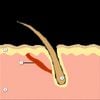community ~5 months topical minoxidil + oral finasteride results (swipe images). Slacked with minoxidil this past month, trying to wean off anyways. My last update because I’m hopping off fin and switching to RU in a few weeks (nothing to do with fin efficacy, just experimenting).
The user experienced significant hair thickening after using topical minoxidil and oral finasteride for about 5 months and is considering switching from finasteride to RU58841. Other users encourage the original poster to continue the current treatment due to the positive results.
